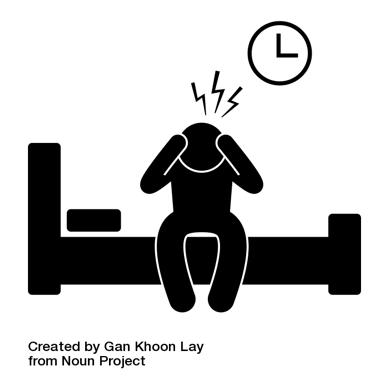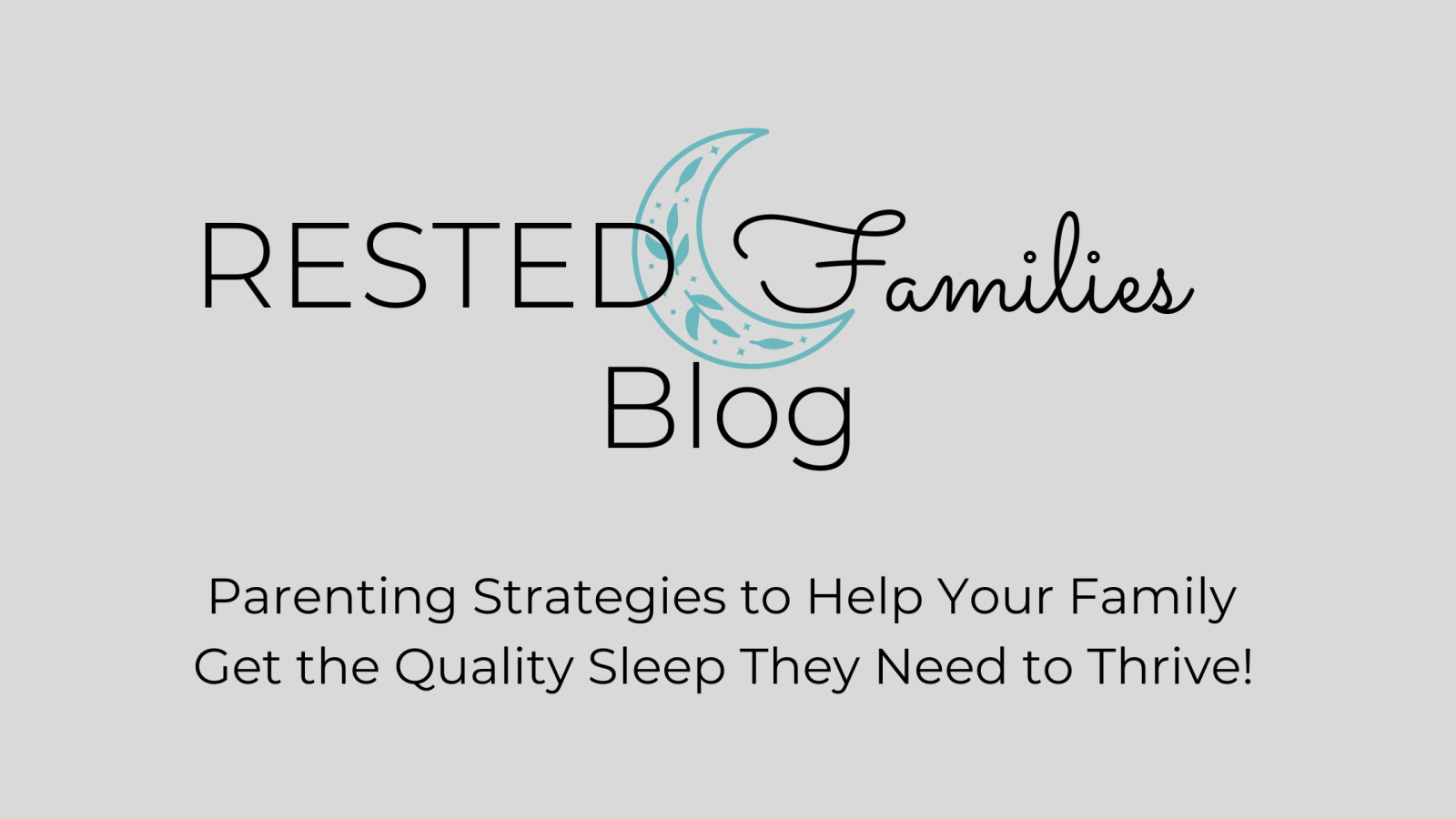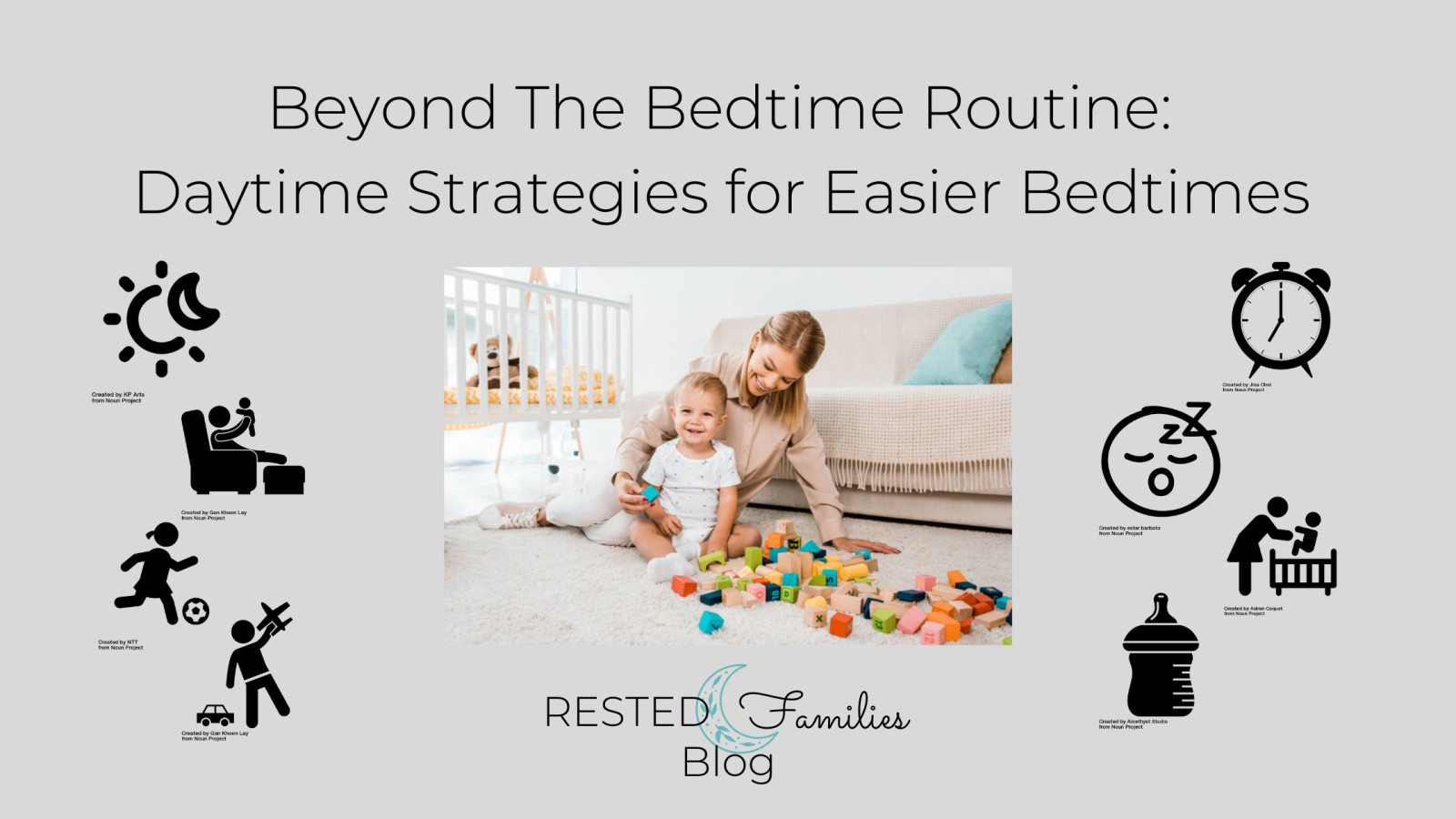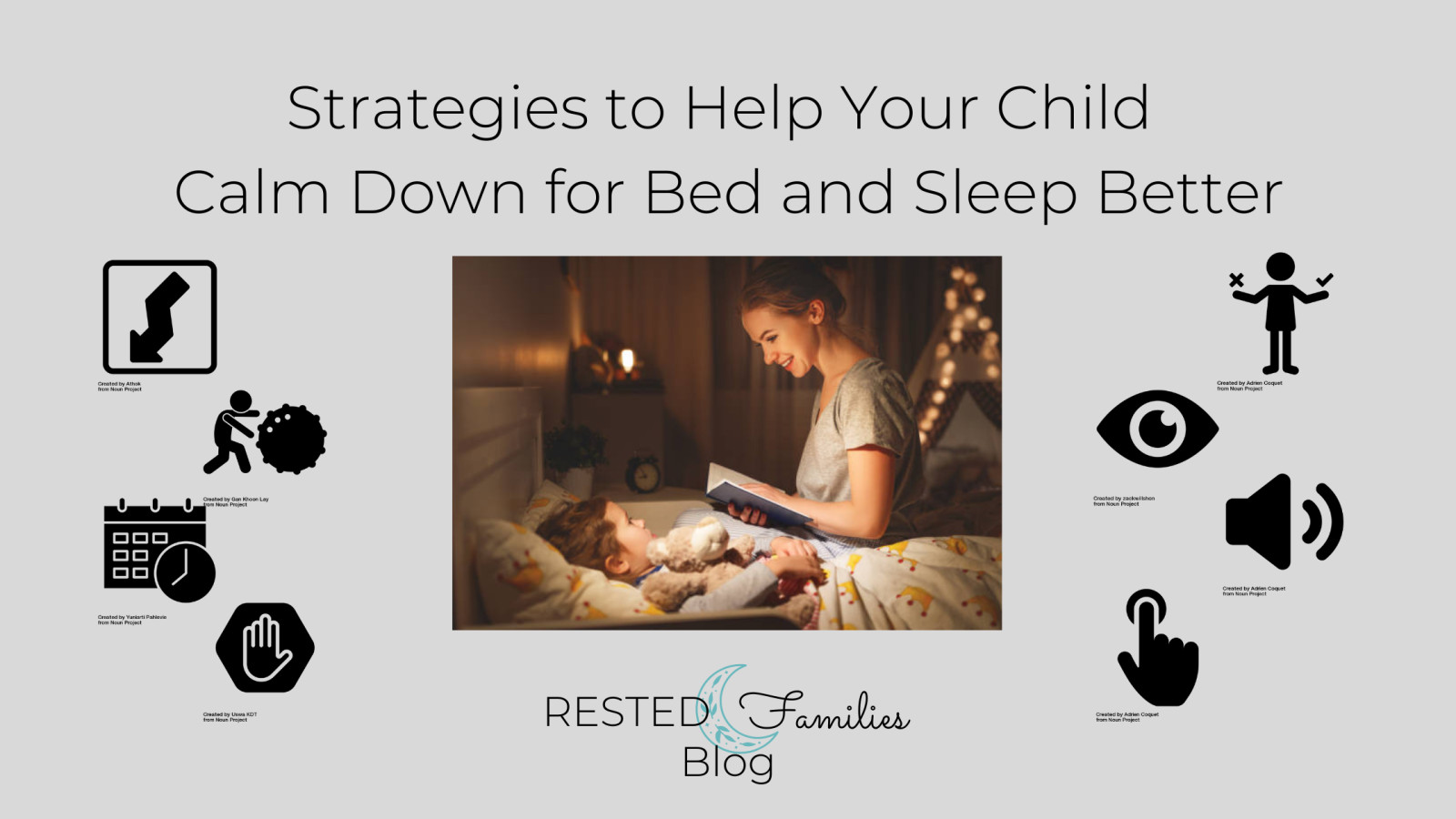
Is nighttime a struggle?
Maybe your child can’t wind down at bedtime. Or maybe they wake up multiple times throughout the night.
Or worse, you’re dealing with bedtime battles and night waking!
Continue reading to learn approaches you can use in the evening to help your child calm down for bed and sleep better throughout the night.
Develop a wind-down routine that's just right for your child. Craft the optimal sleep space for restful nights. Discover parenting strategies that encourage cooperation and more!

Develop a Wind-Down Routine
Children pick up on the behaviors and moods of those around them. So, model winding down in the evening.
If everyone in the house shifts their activity level down a notch, then that will help your child settle and become sleepy.
Start moving slower and talking in a more soothing tone well before getting your child ready for bed.
Dim the lights to encourage your child’s body to produce the sleep-inducing hormone, melatonin.
Even the lights from screens signal to your child’s body to stay alert. Turn off the TV and video games. Put the phone and tablet away.
Transition to calming activities. Avoid intense exercise and toys with bright lights and loud sounds.
If things are lively and exciting, that will stimulate your child. It will keep their brain from calming down.
Your little one won’t want to miss out on the fun others are having. Schedule the entire family’s active and stimulating activities earlier in the day.

Crack Your Child’s Calm Down Code
Some kids find that playing with blocks, working puzzles, or arts and crafts are calming, while others get frustrated and stimulated by those same activities.
So, you’ll need to do some detective work to figure out what calming activities you should save for your child’s wind-down time.
Notice what activities your child enjoys and seems to relax into (except screen time).
Does your child move at full speed all day, even at bedtime? If so, typically calming activities may be insufficient.
Pushing, pulling, and lifting actions may provide the sensory input your child needs to calm down.
Some examples are animal walks, pushing a full laundry basket, putting hefty toys away for the night, and pulling back and forth to Row, Row, Row Your Boat.
Deep-pressure games can help. Roll your child in a blanket like a burrito or layer pillows to make them into a sandwich. Follow by a big bear hug.
Offer playdough to squish or boxes to stack as high as they can. Get creative providing outlets that cater to your child’s unique sensory preferences.
Determine what behaviors help your child calm down. This is very individual!

Squeeze in Connection Time
Let your child choose an activity to do with you during their wind-down routine.
Your child craves your undivided attention. They want to feel loved and worthy of your time.
Meet your child’s desire for connection during daytime and evening routines. In turn, they can more easily separate at bedtime to fall asleep independently.
Scheduling one-on-one time will surprisingly save you time in the long run!

Build a Bedtime Ritual
Follow wind-down time with a pre-sleep ritual.
Go through the same order of events every night prior to bed. Over time those actions will cue your child to prepare for sleep.
We all like to know what to expect. A reliable routine provides predictability and comfort, which aids in calming down and getting sleepy.
Using a visual schedule can help you stick to your child’s bedtime ritual. It will also help your toddler and older child know what’s next.
You can use drawings, pictures, or actual items to symbolize each step of the routine. Or just words if your child is reading.
Another perk of a bedtime ritual is that it encourages compliance. It lessons debates since this is what you do every night.
It includes connection time too!
Utilize the unique calming strategies you identified above to personalize your child’s bedtime ritual and set them up for success.
For example, if your child hates a particular non-negotiable like toothbrushing or hair brushing, then do that early in the routine. Then, add a calming or self-regulating activity directly afterward.
Avoid jumping, rolling, swinging, and spinning. Fast, intense head movements are stimulating. Encourage heavy work activities instead.
Personalize the following bedtime ritual to suit your family’s needs.
- Bath time
- Lavender-scented lotion massage
- PJ’s
- Snack/Milk
- Brush teeth/wipe gums
- Sit in a dimly lit, relaxing space to read a few board books
- Nightly snuggles (hold/rock/rub back)
- Turn on a white noise machine or binaural beats
- Turn off the light together
- Sing a lullaby (cue for sleep)
- Place in crib/bed tired and relaxed, but still awake*
- Use a standard goodnight phrase such as “Goodnight. I love you. See you in the morning.”
*Offer the bottle or breast, snuggle time, and soothing movements early in the ritual so your child learns to fall asleep without them.
When your child can fall asleep independently, then they will know how to drift back to sleep when they slightly awaken between sleep cycles.
Independent sleep skills result in longer stretches of sleep and ultimately “sleeping through the night.”

Don’t Sabotage Self-Soothing Skills
During the first few months after birth, newborns need soothing measures to calm their developing nervous system so they can fall asleep.
When parents continue to provide those soothing actions beyond 3 to 4 months, it masks their baby’s budding abilities to self-soothe.
It keeps your baby from developing independent sleep skills! However, it’s never too late to learn this important life skill.
Slowly back off your assistance to sleep, so your child can develop the ability to self-soothe.
It requires coaching and practice just like learning to read or ride a bike.
There are multiple loving and responsive sleep training methods that parents can choose from.
Utilizing a soothing ladder will prevent you from overhelping your baby to sleep.
- presence
- soothing voice (from shushing to humming, soft singing, and a calming phrase)
- replacing pacifier
- your touch (from light to heavy hand, rub, and pat)
- holding (from still to adding movement)
Always try the lowest level of assistance to see if that will help your child calm down enough to fall asleep. Give it time to work before deciding if you need to increase your assistance.
Talk to your child about the importance of sleep. If they're cognitively 2.5 years or older, then involve them in coming up with a self-soothing plan. Practice with them.
Guide your child in relaxation techniques like using a deep breathing pattern, visualization strategy, or mindfulness exercise.
Older school-age children can relieve anxiety and quiet their minds by making a to-do list or journaling before bed.
Help your child initially and then slowly back off your assistance. Show your confidence that they can do it! Praise progress. Offer incentives.
Then your family will get the quality sleep they need to thrive!

Plan Your Approach to Night Waking
If your baby cries in the middle of the night, wait at least a few minutes to see if they start to self-soothe.
They are likely frustrated that they woke up and are trying to return to sleep.
Babies often find that grunting or humming, moving their head back and forth, rubbing their blanket or hair with their fingers, or another action helps them calm down.
Every baby finds their own soothing strategy!
Babies can be loud self-soothers, so consider if your baby’s fussing, squawking, babbling, etc. is just an effort to self-soothe.
Resist the urge to disrupt your child’s progress in developing their unique technique. They may not need your help. Tune into your child’s needs.
If your child seems truly upset, then go reassure them. Or follow a sleep training method.
Obviously, if they are still young enough to require nighttime feeding, then do so.
You can still offer the necessary space to develop independent sleep skills at bedtime, naps, and after a middle-of-the-night feeding.
If your child is old enough, teach them what to do if they wake up during the night.
Role play. Support them at first, and gradually reduce your participation. They can do it!
Supporting parents in teaching their children independent sleep skills is my specialty! Please reach out if you’d like assistance implementing a plan that is personalized to your family’s needs and preferences.

Use Strategies to Encourage Cooperation
People like to be in control, especially toddlers and young children who are told what to do most of the day.
Give your child choices throughout the day, especially in the evening. Offer choices between two acceptable options.
Would you like the red or blue pajamas? Banana or apple? The book about animals or cars? You do it or I help you?
Even if your child isn’t verbal, they may be able to show you with a reach or point.
When a child is frequently given choices, they feel valued. Then they are more likely to cooperate when the adults in their life enforce rules.
Surprisingly children like clear limits and boundaries. Predictability and consistency are comforting. Inconsistency is confusing and scary.
Enforcing too many rules is exhausting. So, decide what rules are most important. Then hold strong.
Your child will likely push back when a new routine or rule is implemented.
Change is hard and it’s a tough reality that we can’t always get our way, but with consistency, it will become the norm.
A visual schedule and timer often reduce battles. “Sorry, that’s what the schedule/timer says.”
Verbal warnings, timers, schedules, and social stories can ease transitions from one event to the next during your evening routine.
Here are some parenting strategies to encourage positive behavior and make daytime and bedtime easier over time
- set clear expectations
- stick to your word
- praise/reinforce good behaviors
- teach/model more appropriate behaviors
- give choices
- offer plenty of one-on-one attention/child-led play
- apologize when you make a mistake (parenting is tough and no one's perfect)

Design an Optimal Sleep Environment
Even if you’ve incorporated the daytime strategies from my previous blog post and those above, you can still run into bedtime resistance and night waking.
Quite often this is due to your child’s bedroom not being conducive to falling and staying asleep.
The first step should be to ensure your child’s crib or bedroom is safe. Safe sleep recommendations change as a child ages (baby and toddler).
Next, make sure your child’s sleeping environment is relaxing. Take care to remove possible distractions and prevent sleep disturbances.
It’s helpful to consider all our senses when assessing a child’s sleep space. Some little ones are hyper-aware of sensory stimuli.
Something could be disturbing their sleep that you haven’t noticed.
Some children crave certain stimuli and desperately avoid other types. Knowing those preferences helps us provide the best environment.
If your child is verbal, then ask for their input. If not, it may take some trial and error to figure out the most calming setup for your child.

Sight
Some individuals are very sensitive to light. Even a nightlight or light peering through a cracked door can affect their sleep. Television light is just as bothersome.
If a little light is needed for night feedings or diaper changes (or for a fearful child), then make sure it is dim or use red light.
Don’t turn on the overhead light or flash the refrigerator light during the night. Prepare the night before to avoid these behaviors.
Black-out shades are helpful, especially for naps and preventing early morning wake-ups.
Ideally, the room should be free of visual distractions too.
Highly stimulating room décor (bright colors and busy patterns), mobile over the crib, clutter, and nearby toys can be distracting, especially if using a nightlight.
Room sharing is a potential distraction.

Sound
Some individuals are sensitive to noises that others may not notice, such as a ticking clock, a buzzing appliance, or an air conditioner turning on and off.
Close your eyes and listen carefully to figure out if there are any sounds near your child’s sleep space that could be disruptive.
Can the family’s conversations, a TV, or a flushing toilet be heard from a nearby room? Is someone snoring beside them? Is there a dog barking next door?
White noise is soothing to newborns and very useful to drown out household and neighborhood noises that may awaken all ages.
It’s a positive sleep association that I highly recommend using all night and during naps.

Smell
Some individuals are sensitive to smells. Avoid strong air fresheners, perfumes, and laundry detergents.
If the kitchen is nearby, could strong smells be wafting in? Maybe an air purifier would help.
Consider the bedroom’s air quality and circulation.

Taste
This sense isn’t relevant during sleep, but foods eaten during the day can affect sleep.
Once babies start eating solids and drinking things other than breastmilk and formula, their diet should be considered.
Avoid heavy meals just before bed since digestion interferes with sleep. The timing of meals affects our sleep-wake cycle just like lights do!
A small snack is okay and can be a helpful sleep aid to some individuals, but certain foods should be avoided before bed.
Avoid high glycemic index foods since blood sugar spikes and subsequent drops can disturb sleep.
Avoid snacks with lots of saturated fat and trans-fat since that can overwhelm the digestive system as it needs to slow down to sleep.
Spicy and acidic foods before bed can cause indigestion and worsen heartburn and acid reflux.
Consuming caffeine in the afternoon can keep people alert for many hours, even chocolate.
Also, consider the effects of medications and supplements on sleep. Talk to your pediatrician about options if you are concerned.

Touch
Our core body temperature drops as we fall asleep, so a cool room will aid in falling asleep and staying asleep.
The optimum sleep temperature is between 68-72 degrees. Some experts even say 65!
Select pajamas and sleep sacks that are breathable and won’t cause overheating since that will work against quality sleep.
Some individuals are highly sensitive to textures. Choose comfortable fabrics for bedding and clothing. No scratchy tags.
Swaddling a newborn's arms securely will inhibit their startle reflex which is a common sleep disruptor. For safety, swaddle loosely around the hips and discontinue swaddling once your baby show signs of rolling.
Compression clothing or using a heavy blanket* can be calming to some children, just like receiving a hug.
*Make sure to follow the AAP guidelines for safe sleep so you don’t introduce a blanket before it’s safe to do so.
*Weighted blankets can be too heavy and pose safety concerns.

Next Steps
Determine the best evening routine and sleep space for your child.
Guide your child to develop self-soothing skills.
Implementing healthy sleep habits, positive sleep associations, and age-appropriate routines will set your child up for success in becoming an independent sleeper.
Give these strategies sufficient time to work. It can take 21 days to make a habit. So, don’t give up too soon!
Consult your child’s doctor if you suspect a medical issue could be affecting your child’s sleep. Address acid reflux, constipation, dental problems, sleep apnea, seizures, restless leg syndrome, etc. along with these behavioral interventions.
Author Bio: Kendall Hampton is a certified Pediatric Sleep Coach and Developmental Specialist with a B.S. in Human Development and Family Studies. She helps exhausted parents teach their children to fall asleep independently—without guilt or overwhelm. Through personalized plans and supportive coaching, she guides families toward more rest, connection, and confidence. Learn more at restedfamilies.com or follow her on Instagram and Facebook @RestedFamilies.
Would you like to be notified when new RESTED Families Blog Posts are released?










0 Comments